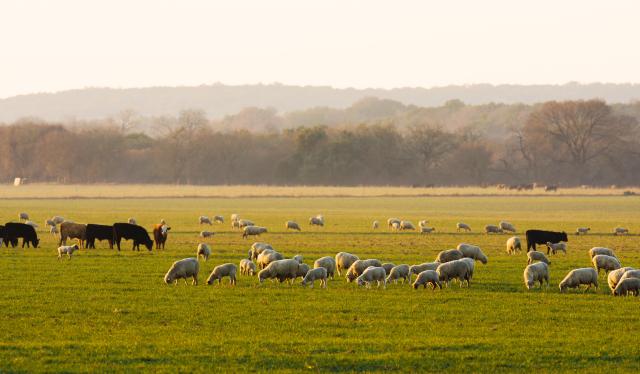A significant breakthrough in understanding Facial Eczema (FE) in livestock brings New Zealand closer to reducing the disease's devastating impact on farmers, animals, and rural communities.


Until recently, sporidesmin, the toxin responsible for FE, was thought to be made by the fungus Pseudopithomyces chartarum (formerly Pithomyces chartarum). However, researchers from AgResearch, Manaaki Whenua, Beef + Lamb New Zealand (B+LNZ) and the Livestock Improvement Corporation have shown that few Pse. chartarum strains appear capable of making sporidesmin, and a new species, Pseudopithomyces toxicarius, is the primary sporidesmin producer, providing a clearer understanding of the disease’s causes, and paving the way for more effective control strategies.
Facial Eczema, caused by sporidesmin produced by the fungus Pse. toxicarius, has cost New Zealand’s economy an estimated $332 million annually.
The study to better understand the fungus associated with FE, which began before the launch of the B+LNZ Eliminating Facial Eczema Impacts (EFEI) programme, is now an important part of the programme’s ongoing efforts to combat FE. By identifying the specific species responsible for FE, researchers have made a crucial advancement to inform where the fungus has now spread and how it can be better managed.
Dan Brier, General Manager of Farming Excellence at B+LNZ, emphasised the significance of the findings, “Facial Eczema has been a long-standing challenge for farmers. This research is a vital step toward understanding the fungus and ultimately eliminating its impact.
“Identifying the species responsible gives us a clearer foundation for developing more accurate diagnostic tools and effective management practices. This collaboration highlights the importance of working together to solve this issue, and we’re proud to contribute to this breakthrough.”
Dr Bevan Weir, Senior scientist at Manaaki Whenua and lead author, added "This breakthrough is the result of years of hard work and dedication from our research teams and the farming community. Identifying Pseudopithomyces toxicarius as the primary cause of Facial Eczema is a critical step forward and a testament to the commitment of everyone involved.”
Christine Voisey, AgResearch, and lead author, reflected, “Working on this project has been one of the most rewarding experiences of my career. There is still much to learn about the biology of Pseudopithomyces, but this research brings us closer to developing tools that will help mitigate the impacts of Facial Eczema on New Zealand’s farmers. We’re grateful to the farmers who supported us by providing samples for this vital research.”
Dr Cara Brosnahan, Principal Scientist in Animal Health Research at B+LNZ and co-author of the study, said, "Facial Eczema is not just a disease; it’s a burden on many farmers and their livelihoods. This research is an essential leap forward, giving us the knowledge we need to tackle the problem head-on. By understanding the fungus behind the disease, we will be able to empower farmers with knowledge and better tools to safeguard their stock and secure their futures."
This research confirms that while some species of Pseudopithomyces do not produce the toxic compound sporidesmin, Pse. toxicarius, which resembles Pse. chartarum closelyand is easilymisidentified, is the primary species associated with FE. This finding will improve how FE risk is assessed, as the current spore counting methods may have included non-toxic spores, leading to inaccurate risk assessments.
However, this doesn’t discount pasture or faecal spore counting as valuable, Dr Brosnahan urges farmers to still keep monitoring and participating in studies like the B+LNZ Sheep poo study, “Spore counting remains an important tool for farmers to understand and manage FE risk in their regions, this discovery compliments that by providing a clearer basis for future research and more precise risk management strategies.”
“Bringing together farmer-led organisations and researchers is key to delivering practical outcomes that truly make a difference on the ground. By combining real-world farming experience with scientific expertise, we ensure that research is not just theoretical but directly applicable to the challenges farmers face every day," adds Brier.
As the EFEI programme continues its work, this collaborative research from Beef + Lamb New Zealand, AgResearch, Manaaki Whenua and LIC represents a crucial step in solving the challenges of Facial Eczema. With a clearer understanding of the fungus that produces sporidesmin, researchers are now better equipped to develop tools and diagnostics that will help eliminate the effects of FE on New Zealand’s farming industry.
Publication:
Weir, B.S.; Sidhu, J.S.; Brosnahan, C.L.; Lee, D.; Maclean, P.H.; Park, D.; Jauregui, R.; Johnson, R.D.; Petterson, M.E.; Williams, A.F.R.; Morse, N.R.; Sprosen, J.M.; Lim, Y.-W.; Bridgeman, B.J.; Walker, T.J.; Kumar, S.; Mace, W.J.; Prakash, S.; Liu, X.; Hume, D.E.; Couldrey, C.; Beever, R.E.; Voisey, C.R. (2025) Global diversity analysis of plant-associated Pseudopithomyces fungi reveals a new species producing the toxin associated with facial eczema in livestock: Pseudopithomyces toxicarius sp. nov. Studies in Mycology 112: 39-73.
ENDS
For media queries, email [email protected]